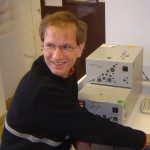Link to Pubmed [PMID] – 25524456
Mol. Cell. Endocrinol. 2015 Feb;401:173-88
PRLR(I146L) is the first identified gain-of-function variant of the prolactin receptor (PRLR) that was proposed to be associated with benign breast tumorigenesis. Structural investigations suggested this hydrophobic core position in the extracellular D2 domain to be linked to receptor dimerization. Here, we used a mutational approach to address how the conservative I-to-L substitution induced constitutive activity. Using cell-based assays of different I146-PRLR variants in combination with spectroscopic/nuclear magnetic resonance analyses we found that chemical manipulation of position 146 profoundly altered folding, PRL-responsiveness, and ligand-independent activity of the receptor in a mutation-specific manner. Together, these data further add to the critical role of position 146, showing it to also be crucial to structural integrity thereby imposing on the biological PRLR properties. When stably introduced in MCF-7 (luminal) and MDA-MB231 (mesenchymal) breast cancer cells, the most potent of the PRL-insensitive mutants (PRLR(I146D)) had minimal impact on cell proliferation and cell differentiation status.

